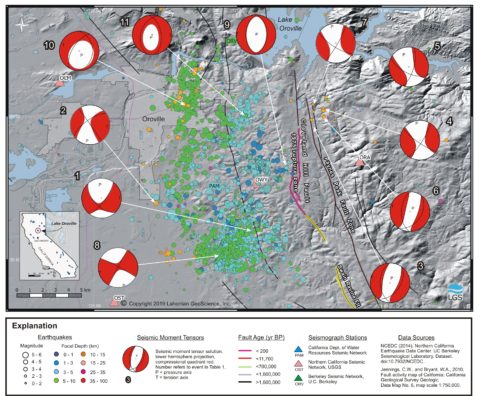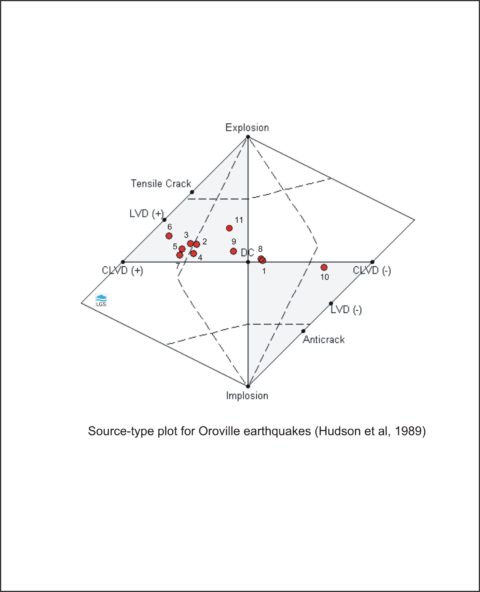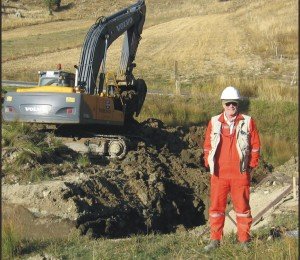
-
Distribution of earthquakes with shear tensile mechanisms indicating reservoir triggered seismicity
Figure 1 - Seismic moment tensor solutions for some post-1983 earthquakes near Lake Oroville. Earthquakes 2 – 7, 10 and 11 have non-double couple sources and are evidence of reservoir triggered seismicity. The other events have double-couple faulting sources typical of naturally occurring tectonic earthquakes. Earthquake epicenters located by the NCEDC are depicted as circles colored by their focal depth.
Figure 1 - Seismic moment tensor solutions for some post-1983 earthquakes near Lake Oroville. Earthquakes 2 – 7, 10 and 11 have non-double couple sources and are evidence of reservoir triggered seismicity. The other events have double-couple faulting sources typical of naturally occurring tectonic earthquakes. Earthquake epicenters located by the NCEDC are depicted as circles colored by their focal depth.
-
Decomposition of seismic moment tensors for select earthquakes near Lake Oroville, California
Figure 2 - A Hudson source-type plot showing the decomposition of seismic moment tensors from some post-1983 earthquakes near Lake Oroville. Earthquakes that plot to the upper left have shear tensile faulting sources typical of reservoir-triggered seismicity.
Figure 2 - A Hudson source-type plot showing the decomposition of seismic moment tensors from some post-1983 earthquakes near Lake Oroville. Earthquakes that plot to the upper left have shear tensile faulting sources typical of reservoir-triggered seismicity.
Evidence for Reservoir Triggered Seismicity at Lake Oroville, California
Introduction
An association between earthquakes and human activities has been recognized since the beginning of the 20th century (McGarr et al., 2002). These earthquakes are caused by industrial processes that result in stress changes on faults, either by reducing the confining (normal) stress or increasing the driving (shear) stress. Among the anthropogenic sources causing earthquakes are mining, hydrocarbon production, wastewater disposal and the filling of water reservoirs behind dams. Earthquake activity caused by reservoir impoundment is referred to as reservoir triggered seismicity.
Reservoir Triggered Seismicity
Earthquakes are considered to be triggered if fault failure is initiated by anthropogenic stress changes that are smaller than the total stress released in the event (McGarr et al., 2002). This is because the faults that slip are already under a tectonic stress load and are often in a pre-critical state, needing just a small increase in stress to fail. In the case of reservoir triggered seismicity, an earthquake is caused by an increase in crustal stress due to the weight of the water in the reservoir, an increase in fluid pressure on a fault caused by subsurface migration of water from the reservoir or a combination of both effects (Simpson et al., 1988).
The earliest known cases of reservoir triggered seismicity occurred in the 1930s (McGarr et al, 2002). Since then over 100 cases of reservoir triggered seismicity worldwide have been recognized (Foulger et al., 2017). Most of these cases involve maximum magnitudes of less than 5, resulting in little to no damage. Two of the largest magnitude events thought to have been triggered by reservoir impoundment are the 1959 Ms 7.1 Hebgen Lake, Montana, and the 2008 Mw 7.9 Wenchuan, China, earthquakes (Foulger et al., 2017).
Discriminating between Earthquake Types
Discrimination between naturally occurring (i.e., tectonic) earthquakes and those caused by a reservoir is important for two reasons. First, it is necessary to determine whether the reservoir operations are actually causing the earthquakes or if the seismic activity is coincidental. Second, in tectonically active regions (such as California) it is important to identify which faults are responding to the increase in pore fluid pressure. Faults that are favorably oriented to the existing tectonic stress field are likely to result in larger magnitude earthquakes when triggered. This is because the rate of tectonic stress accumulation is greater on favorably oriented faults than those misoriented to the stress field (Sibson, 1990).
1975 Lake Oroville Earthquake
To investigate how tectonic earthquakes can be distinguished from triggered ones, LGS conducted a preliminary analysis of earthquakes near Lake Oroville in Butte County, California, a tectonically active region (Figure 1). Lake Oroville is impounded by the 235-meter-high Oroville Dam, the tallest in the USA. It has a storage capacity of 4.3 cubic kilometers and a maximum depth of 220 meters (Toppozada and Morrison, 1982). Completed in 1967, the dam provides flood control on the Feather River, water storage and generates hydroelectric power. On 1 August 1975 the Lake Oroville area experienced a ML 5.7 earthquake. The event was located on the Cleveland Hill fault about 13 km south of the dam (Lahr et al., 1976).
The proximity of the 1975 earthquake to Lake Oroville led scientists to debate if this was a case of reservoir triggered seismicity (see Gupta, 1992, for a review). Below, we discuss the initial results of this study in which the seismic moment tensor is used to distinguish tectonic from triggered earthquakes. The objective of this study is to demonstrate that reservoir triggered seismicity exists near the reservoir.
Data and Method
Our approach utilizes a decomposition of the full seismic moment tensor into isotropic (ISO), double-couple (DC) and compensated linear vector dipole (CLVD) components to discriminate between natural and reservoir triggered earthquakes (Lizurek, 2017). The seismic moment tensor is a description of the equivalent body forces acting at the earthquake source to cause deformation in the far field (Vavrycuk, 2015). It provides a fundamental description of a seismic source at all scales, from acoustic emissions to large earthquakes.
Earthquake Source Mechanisms
Naturally occurring tectonic earthquakes are generally characterized by pure shearing on active fault planes, i.e., they have a DC source mechanism. In pure shearing the slip vector is contained in the plane of failure. Earthquakes induced or triggered by anthropogenic activities such as mining, wastewater injection, hydrocarbon extraction or reservoir impoundment have significant non-double-couple components (ISO and CLVD) in the moment tensor (Vavrycuk, 2002). For sources with significant ISO components, the slip vector lies at an angle outside the fault plane. Positive ISO and CLVD components indicate earthquake source processes involving crack opening and negative ISO and CLVD components indicate crack closing. In evaluating reservoir triggered seismicity the opening and closing of cracks can be considered evidence of fluctuating fluid pressures caused by reservoir operations (i.e., repeated filling and draining of the reservoir).
Earthquakes and Faults in the Lake Oroville Region
In Figure 1 the epicenters of earthquakes that occurred from 1971 to 2018 near Lake Oroville are shown as circles, colored and sized with respect to depth and magnitude. The locations are taken from the Northern California Earthquake Catalog (NCEDC, 2014). The ML5.7 mainshock is located southwest of the town of Palermo.
Faults in the region are shown as black lines, highlighted in color if they have ruptured in the Quaternary (Jennings and Bryant, 2010). These Quaternary faults are part of the Foothills Fault System, a 200-mile-long zone of faulting trending northwest at the western margin of the Sierra Nevada (Clark, 1960). The reach of the Cleveland Hill fault that ruptured in August 1975 is highlighted in magenta. Both the Cleveland Hill fault and the Swain Ravine fault dip to the west while the Paynes Peak fault zone dips to the east (Aune, 1975).
Calculating Seismic Moment Tensors
We calculated the seismic moment tensors for 11 Oroville earthquakes that were recorded from 1984 to 2018, with magnitudes ranging from 1.6 to 3.2 (NCEDC, 2014). This analysis is restricted to earthquakes recorded after 1983 when digital data for northern California became routinely available from the NCEDC. The full seismic moment tensors were determined by inverting the spectral ordinates of the P-wave pulse from vertical component velocity seismograms for each earthquake (Kwiatek et al., 2016).
Results
Moment Tensor Solutions
The results of our analysis are shown in Figure 1. The moment tensor solutions are shown by the red and white beachball symbols (equal area, lower hemisphere projection), which depict the P-wave radiation pattern around the earthquake source. The regions of compression (red) and dilatation (white) model the far-field ground motion recorded by seismograph stations. The curved lines in the interior of the beachballs represent the nodal planes for the DC component of the moment tensor solution. The numbers beside the beachballs identify the earthquakes in Figure 2. The moment tensors solutions indicate a mix of DC and non-DC faulting sources south of the lake.
Distribution of Source Processes
Another way of summarizing the results of the moment tensor inversions is to plot the solutions on a Hudson source-type plot shown in Figure 2 (Hudson et al., 1989). This plot graphically displays the contributions to each earthquake source from the ISO, DC and CLVD components. Earthquake sources that involve pure shear faulting plot near the center of the figure (DC, events 1, 8, 9) and are the result of the release of tectonic shear strain. Earthquakes that plot in the positive CLVD-ISO quadrant (events 2 – 7 and 11) have shear tensile dislocation sources (shearing and crack opening), events that plot in the negative CLVD-ISO quadrant have shear compressive sources (shearing and crack closing, event 10).
Conclusions
Based on this preliminary analysis, we suggest that the occurrence of tensile earthquakes near Lake Oroville post 1983 is evidence of reservoir triggered seismicity. Tensile faulting is generally associated with geothermal or volcanic activity where high pore fluid pressures are known to exist (Julian et al., 1998, Martinez-Garcon et al., 2017). It is also associated with anthropogenic activities such as hydrofracking, wastewater injection, mining, and reservoir impoundment (McGarr et al., 2002, Grigoli et al., 2017). We note that the decomposition of the full moment tensor into isotropic and deviatoric components does not provide a unique understanding of the earthquake source. A non-DC solution could also be caused by slip along a nonplanar fault surface, a simultaneous rupture of two fault segments, shear faulting in anisotropic media, polymorphic phase transformations or errors in modeling (Julian et al., 1998; Lizurek, 2017).
However, given the proximity of Lake Oroville (a source for fluid and hydraulic driving stress), the intersection of the Cleveland Hill and Paynes Peak faults with the reservoir (providing pathways for fluid migration; see Figure 1) and the occurrence of tensile earthquake sources, it is reasonable to assume that fluid pressure on the faults is sufficiently high to cause earthquakes in the area south of Lake Oroville. Furthermore, it is also reasonable to assume that reservoir triggered seismicity would have occurred in this area sometime after the reservoir was filled in 1968 and would have been a factor in initiating the 1975 earthquake sequence.
More Information on Reservoir Triggered Seismicity
Earthquakes triggered or induced by human activities have grown in number over the past decade with the development of new oil and gas extraction technologies (i.e., hydrofracking) and an increasing need to dispose of wastewater generated from hydrocarbon production wells as the US has evolved into one of the world’s largest producers. A very good summary of the characteristics of human induced earthquakes has been published by Foulger et al. (2017), which also provides a searchable database of induced seismicity cases worldwide.
References
Aune, Q.A., 1975. Geomorphic Setting of the Cleveland Hill Fault, Southern Butte County, California, in R.W. Sherbourne and C.J. Hauge eds., Oroville, California Earthquake, 1 August 1975: California Division of Mines and Geology Special Report 124.
Foulger, Gillian R. and Wilson, Miles and Gluyas, Jon and Julian, Bruce R. and Davies, Richard (2018) ‘Global review of human-induced earthquakes.’, Earth-science reviews., 178, pp. 438-514.
Grigoli, F., Cesca, S., Priolo, E., Rinaldi, A. P., Clinton, J. F., Stabile, T. A., Dost, B., Fernandez, M. G., Wiemer, S., and Dahm, T. ( 2017), Current challenges in monitoring, discrimination, and management of induced seismicity related to underground industrial activities: A European perspective, Rev. Geophys., 55, 310– 340, doi:10.1002/2016RG000542.
Gupta, H. K. (2002). A review of recent studies of triggered earthquakes by artificial water reservoirs with special emphasis on earthquakes in Koyna, India, Earth Sci. Rev. 58, no. 3, 279–310.
Hudson, J. A., R. G. Pearce, and R. M. Rogers (1989), Source type plot for inversion of the moment tensor, J. Geophys. Res., 94, 765–774, doi:10.1029/JB094iB01p00765.
Julian, B. R., A. D. Miller, and G. R. Foulger (1998), Non-double-couple earthquakes: 1. Theory, Rev. Geophys., 36, 525–549, doi:10.1029/98RG00716.
Knopoff, L., and M. J. Randall (1970). The compensated linear-vector dipole. A possible mechanism for deep earthquakes, J. Geophys. Res. 75, 1957–1963.
Kwiatek, G., P. Martínez-Garzón, and M. Bohnhoff (2016), HybridMT: A MATLAB/Shell environment package for seismic moment tensor inversion and refinement, Seismol. Res. Lett., doi:10.1785/0220150251.
Lizurek, G. (2016). Full Moment Tensor Inversion as a Practical Tool in Case of Discrimination of Tectonic and Anthropogenic Seismicity in Poland. Pure Appl. Geophys. 174 (2017), 197–212, DOI 10.1007/s00024-016-1378-9.
Martínez-Garzon, P., Kwiatek, G., Bohnhoff, M., and Dresen, G. (2017). Volumetric components in the earthquake source related to fluid injection and stress state. Geophysical Research Letters, 44(2), 800-809.
McGarr, A., Simpson, D., and Seeber, L. (2002). Case histories of induced and triggered seismicity. International Geophysics Series, 81(A), 647-664.
NCEDC (2014), Northern California Earthquake Data Center. UC Berkeley Seismological Laboratory. Dataset. doi:10.7932/NCEDC.
Simpson D.W., W.S. Leith & C.H. Scholz, 1988, Two types of reservoir induced seismicity, Bulletin of the Seismological Society of America, 78, 2025-40.
Toppozada, T. R. and Morrison, P.W., 1982. Earthquake and Lake Levels at Oroville, California, California Geology, v.35, no. 6.
Vavryčuk, V. (2002), Non-double-couple earthquakes of 1997 January in West Bohemia, Czech Republic: Evidence of tensile faulting, Geophys. J. Int., 149(2), 364–373, doi:10.1046/j.1365-246X.2002.01654.x.
Revised: 2019-12-3

